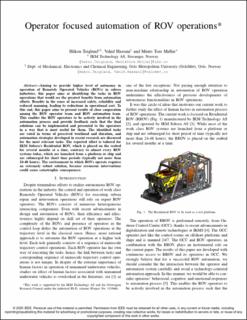| dc.contributor.author | Teigland, Håkon | |
| dc.contributor.author | Hassani, Vahid | |
| dc.contributor.author | Møller, Ments Tore | |
| dc.date.accessioned | 2021-01-15T11:40:44Z | |
| dc.date.accessioned | 2021-02-25T12:38:07Z | |
| dc.date.available | 2021-01-15T11:40:44Z | |
| dc.date.available | 2021-02-25T12:38:07Z | |
| dc.date.issued | 2020-11-30 | |
| dc.identifier.citation | Teigland H, Hassani V, Møller MT. Operator focused automation of ROV operations. Proceedings of the Symposium on Autonomous Underwater Vehicle Technology. 2020:1 | en |
| dc.identifier.isbn | 978-1-7281-8757-0 | |
| dc.identifier.isbn | 978-1-7281-8758-7 | |
| dc.identifier.issn | 1522-3167 | |
| dc.identifier.issn | 2377-6536 | |
| dc.identifier.uri | https://hdl.handle.net/10642/9745 | |
| dc.description.abstract | Aiming to provide higher level of autonomy in operation of Remotely Operated Vehicles (ROVs) in subsea industries, this paper aims at identifying the tasks in ROV operations that would see the greatest benefits from automation efforts. Benefits in the sense of increased safety, reliability and reduced manning, leading to reductions in operational cost. To this end, this paper aims to present results of close cooperation among the ROV operator team and ROV automation team. This enables the ROV operators to be actively involved in the automation process and provide feedback such that the final solutions can be implemented and presented to the operators in a way that is most useful for them. The identified tasks are rated in terms of perceived workload and duration, and automation strategies developed in recent research are discussed for the most relevant tasks. The reported effort is tailored for IKM Subsea’s Residential ROV, which is placed on the seabed for several months at a time, contrary to almost every ROV systems today, which are launched from a platform or ship and are submerged for short time periods (typically not more than 24-48 hours). The environment in which ROVs operate requires an extremely robust solution, because erroneous interventions could cause catastrophic consequences. | en |
| dc.description.sponsorship | This work is supported by the IKM Technology AS and the Norwegian Research Council under the industrial Ph.D. scheme (Project No. 313866). | en |
| dc.language.iso | en | en |
| dc.publisher | IEEE | en |
| dc.relation.ispartof | 2020 IEEE/OES Autonomous Underwater Vehicles Symposium (AUV) | |
| dc.relation.ispartofseries | Symposium on Autonomous Underwater Vehicle Technology (AUV); 2020 IEEE/OES Autonomous Underwater Vehicles Symposium (AUV) | |
| dc.rights | IEEE policy provides that authors are free to follow funder public access mandates to post accepted articles in repositories. When posting in a repository, the IEEE embargo period is 24 months. | en |
| dc.subject | Unmanned underwater vehicles | en |
| dc.subject | Remotely operated vehicles | en |
| dc.subject | Autonomous vehicles | en |
| dc.subject | Teleoperators | en |
| dc.subject | Robot controls | en |
| dc.title | Operator focused automation of ROV operations | en |
| dc.type | Journal article | en |
| dc.type | Peer reviewed | en |
| dc.date.updated | 2021-01-15T11:40:44Z | |
| dc.description.version | acceptedVersion | en |
| dc.identifier.doi | http://doi.org/10.1109/AUV50043.2020.9267917 | |
| dc.identifier.cristin | 1872080 | |
| dc.source.journal | Proceedings of the Symposium on Autonomous Underwater Vehicle Technology | |
| dc.relation.projectID | Norges forskningsråd: 313866 | |
